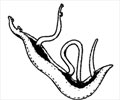Scientists have speculated that soil-dwelling parasitic worms use their sense of smell to find suitable hosts for infection.

To study worm olfaction, Elissa Hallem, from the University of California Los Angeles, USA, and colleagues examined the host-seeking strategies and sensory behaviors of different roundworms. They compared three skin-penetrating parasitic species, including Strongloides stercoralis, the threadworm that causes the serious and common disease strongyloidiasis, with five other worm species of diverse lifestyles and ecological niches.
Some of the species, including Str. stercoralis are "cruisers" that are highly mobile and actively search for hosts, others are "ambushers" that seem to wait for passing hosts and display little unstimulated movement, and some use an intermediate strategy. All of the worm species studied, regardless of host-seeking strategy, react to different odors. They are attracted by some smells and repelled by others, and each species has a unique odor response profile. Str. stercoralis, at its infective juvenile stage, for example, is attracted to odors of human skin and sweat. And Haemonchus contortus, which infects cattle, is attracted by odors of grass and cow breath, which puts it in a perfect position to enter the digestive tract of its host.
Comparing these profiles, the researchers found that those of species with similar hosts were most similar, and this was true even when the species were not closely related. The fact that host specificity rather than relatedness predicts similar olfactory preferences suggests that a worm's sense of smell does indeed play an important role in host location and selection.
The researchers suggest that "the identification of odorants that attract or repel Str. stercoralis and other parasitic nematodes lays a foundation for the design of targeted traps or repellents, which could have broad implications for nematode control". And as "nearly all of the attractants identified for Str. stercoralis also attract anthropophilic mosquitoes [those that feed on humans]" and "Str. stercoralis and disease-causing mosquitoes are co-endemic throughout the world", they say their results "raise the possibility of designing traps that are effective against both".
Advertisement










